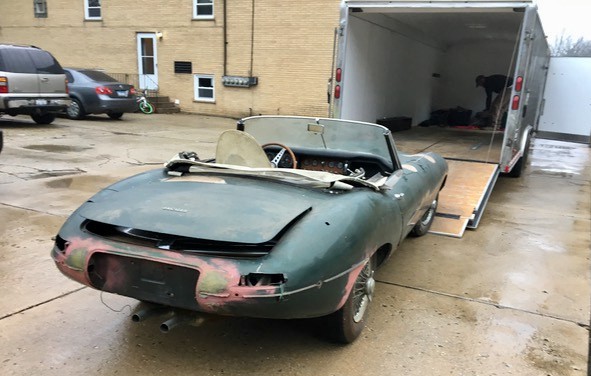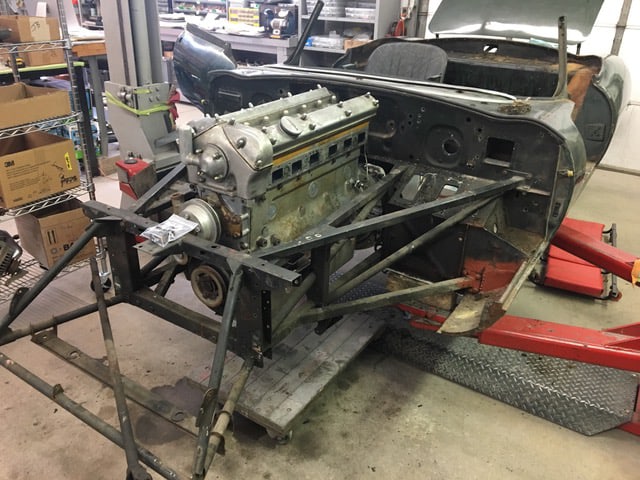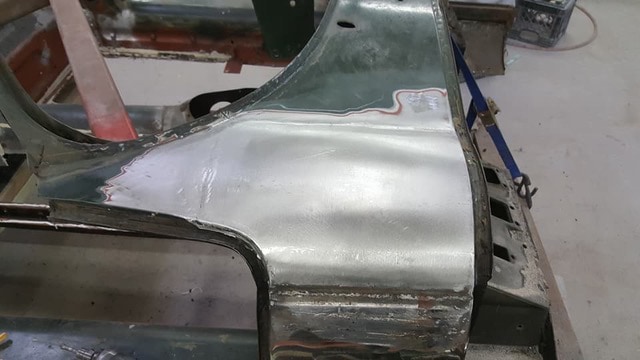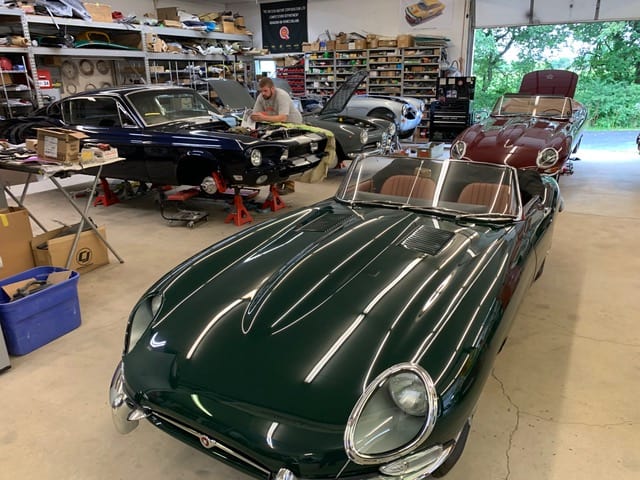Seriously, do not pass Go and do not collect $200 until you’ve considered the time and the cost and the labor involved

A classic Jaguar E-type roadster arrives at Sport and Specialty Restorations…

The same Jaguar, but now after months of talent and time and money have been poured into its restoration | John Saccameno photos
Let me set the stage. You are looking at the car you always dreamed of owning, let’s say, just for example, it is an Austin Healey 3000 and it seems to be a solid example of the model. You have always wanted a Healey 3000 and this specific example will need a restoration, but the price seems right and it doesn’t look like it would take much to make it great again.
Besides, you have some extra money right now and are sure you can handle it, and you have always wanted to go thru the process of having a car restored to perfection. You even tell yourself, “Who knows, I bet I can save some money on the restoration and do a lot of the work myself.”
Heck, you have done tuneups and other things to cars in the past and you think if you just take you time and with the help of a good manual, there are likely a lot of things you can accomplish.
The car is being offered for only $20,000 and it still runs and drives, though not very well. You are sure you can buy the car, restore it and at some point sell it for much more than your costs to buy the car and restore it and make some extra money. Why not buy it and go for it?
STOP RIGHT THERE! Do not pass Go and do not expect to collect $200.
This is a story I hear over and over again. I’ve also fallen victim to this pipedream.
However, car restoration is not for the faint hearted and it is never — I repeat — never inexpensive. There are no bargains on restorations, only bad restorations or good restorations. There is also no such thing as a driver-level restoration. There is only one way to restore a car and that is completely. Any car that is described as partially restored is likely to have had a brake job and a fresh coat of paint, and not a bare metal respray just a scuff and a new paint finish over the old one. That is not a restoration.
Yes, there are a number of shops that will say you can restore your car inexpensively and will give you a quote for say $25,000. Do not believe what they tell you. If you go this route one of two things will happen, either you will get a bad quality job or you will have the shop owner calling you every few weeks to tell you that again your car’s restorations requires more money. This is what people in the industry call the elevator ride.
If what you want at the end is a restored car, you go to a reputable shop and get your car restored. If you simply want a driver-level car, buy one and enjoy it and stop reading now. If, on the other hand, you have enough disposable income and really have wanted to restore a car to as good as it was new, please continue reading.

Some things are obvious, others aren’t revealed until the car is taken apart and the paint is removed

The Jaguar after its disassembly

Just one example of repairs needed after the paint is removed
Car restoration is a time consuming, stress inducing, labor intensive, and expensive endeavor. If that does not sound like fun, stop reading and don’t consider restoring a car, or more importantly buying a restoration project you cannot afford. If the car is so special, why didn’t the seller restore it in the first place? Likely because after they messed around with it a little and got a few quotes from good shops, they were scared away.
Let’s start with the last bad idea first. If you are looking to have a car restored with the idea of making a few bucks at the end, you are 99 percent of the time likely to be quite disappointed. If the car is a Series 2 XKE, a TR6/MGB/Healey 3000/Porsche 914 or anything other sub-$100,000 car, you are never likely to make any money on the deal and will almost assuredly be upside down in the car after writing your first check. Cars of this ilk never make sense to restore.
On the other hand, if you love the process of bring a car back to its former glory, have a specific emotional attachment to a specific car — for example, your father owned it new — and have the disposable income to write some big checks, restoring a car might be the right decision.
But say the car in question is an Aston Martin DB4 GT, or a Ferrari 250 series car, or even a 1973 Porsche 911 Carrera RS, if you bought these cars for a lower price it may well make sense to consider a restoration.
The difference between these cars and the others listed above is that no matter what car you choose to restore, be it an Aston Martin or a Triumph, they all take time, and lots of it, to restore. Sure, Triumph parts are much less expensive than Aston martin parts but the amount of paid for labor is the same.
According to Paul Russell ,from highly respected Paul Russell and Company (the restoration shop with more concours wins than any other in the world) the average restoration of a Mercedes-Benz 300SL roadster takes a minimum of — are you sitting down — 3,500 hours. Do the math, at a very reasonable and hard to find labor rate of $80 dollars an hour, that adds up to $280,000 in labor alone. That does not include parts, materials (paint, sandpaper, chemicals) or machine shop time.
Even a more average model car, say a Triumph TR6, is likely to take around 750 hours in labor. That at the same labor rate equals $60,000 in labor.
Let’s get a second opinion. I asked John Saccameno the owner of Sport and Specialty Restorations, who last year completed the restoration of what the Jaguar Club of North America voted to be the finest XKE restoration in the US.. He figures that a car like an MGB or TR6 or Healey 3000 would easily take a minimum of 600 hours of labor and that’s only if the car does not need any extensive bodywork or fabrication. That adds up to at least $48,000 in labor.
Russell said that the first thing he asks a client before a restoration is, “What are your plans with the car. What are you going to use it for?”
If the answer is that they just want a nice driver car, he always recommends simply buying a car that is already done and fulfills their needs. Saccameno echoed Russell and said he talks more than half of potential customers out of doing a restoration.
So, when should you restore a car? Russell and Saccameno recommend a restoration for those customers who have an heirloom car, something that has been in the family a long time and has become more a member of the family that just a car. They also recommend restorations for cars that are important, for example, a car that was displayed at the 1965 Geneva Motor Show or a historic vehicle with unique features.
An exception both note, however, is the customer who, regardless of the car they are restoring, simply loves the process of bring a car back to the way it was when new.

The Jaguar restored and ready to return to its owner
If your plan is to make a lot of money from the car when it is done, this most likely is not going to happen. Sure, you can do this, but it either takes a buy that is so low as to be under market price for even a project or an incredible amount of luck and usually a bit of both.
Finally let’s move to the idea that you can do much of the work yourself. This can work, but first ask yourself a few questions. How experienced are you in mechanical things? Are many of the car’s needs things you are able to accomplish properly? YouTube videos can be a help, but do you have the skills as well as the tools to accomplish the job?
Next, do you have the space needed to do the job? You can do this in your garage you will be amazed at how much space parts will take. Finally, do you have the necessary time to do the work? If the answers to all of these questions is yes, then you might consider this path.
However, keep in mind that it will cost more in time and money than you expect. A good rule of thumb is to budget that time and money out as best as you can and then add at least 30 percent to such figures.
So, if after reading this you are still considering restoring a car ,then by all means move forward. If not, don’t be glum but consider a new paint job to improve your car’s appearance — but again, go to a reputable shop.
By the way, our next story will help you in your quest for reputable and reliable restoration businesses.




